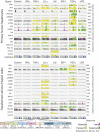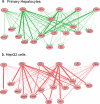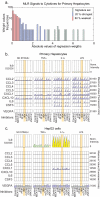Networks inferred from biochemical data reveal profound differences in toll-like receptor and inflammatory signaling between normal and transformed hepatocytes
- PMID: 20460255
- PMCID: PMC2938121
- DOI: 10.1074/mcp.M110.000406
Networks inferred from biochemical data reveal profound differences in toll-like receptor and inflammatory signaling between normal and transformed hepatocytes
Abstract
Systematic study of cell signaling networks increasingly involves high throughput proteomics, transcriptional profiling, and automated literature mining with the aim of assembling large scale interaction networks. In contrast, functional analysis of cell signaling usually focuses on a much smaller sets of proteins and eschews computation but focuses directly on cellular responses to environment and perturbation. We sought to combine these two traditions by collecting cell response measures on a reasonably large scale and then attempting to infer differences in network topology between two cell types. Human hepatocytes and hepatocellular carcinoma cell lines were exposed to inducers of inflammation, innate immunity, and proliferation in the presence and absence of small molecule drugs, and multiplex biochemical measurement was then performed on intra- and extracellular signaling molecules. We uncovered major differences between primary and transformed hepatocytes with respect to the engagement of toll-like receptor and NF-kappaB-dependent secretion of chemokines and cytokines that prime and attract immune cells. Overall, our results serve as a proof of principle for an approach to network analysis that is systematic, comparative, and biochemically focused. More specifically, our data support the hypothesis that hepatocellular carcinoma cells down-regulate normal inflammatory and immune responses to avoid immune editing.
Figures











References
-
- Pieroni E., de la Fuente van Bentem S., Mancosu G., Capobianco E., Hirt H., de la Fuente A. (2008) Protein networking: insights into global functional organization of proteomes. Proteomics 8, 799–816 - PubMed
-
- Joughin B. A., Cheung E., Karuturi R., Saez-Rodriguez J., Lauffenburger D. A., Liu E. T. (2009) Cellular signaling networks, in Systems Biomedicine: Concepts and Perspective (Liu T., Lauffenburger D. A. eds) Academic Press; New York
-
- Cusick M. E., Klitgord N., Vidal M., Hill D. E. (2005) Interactome: gateway into systems biology. Hum. Mol. Genet. 14, R171–R181 - PubMed
-
- Russell R. B., Aloy P. (2008) Targeting and tinkering with interaction networks. Nat. Chem. Biol. 4, 666–673 - PubMed
-
- Rual J. F., Venkatesan K., Hao T., Hirozane-Kishikawa T., Dricot A., Li N., Berriz G. F., Gibbons F. D., Dreze M., Ayivi-Guedehoussou N., Klitgord N., Simon C., Boxem M., Milstein S., Rosenberg J., Goldberg D. S., Zhang L. V., Wong S. L., Franklin G., Li S., Albala J. S., Lim J., Fraughton C., Llamosas E., Cevik S., Bex C., Lamesch P., Sikorski R. S., Vandenhaute J., Zoghbi H. Y., Smolyar A., Bosak S., Sequerra R., Doucette-Stamm L., Cusick M. E., Hill D. E., Roth F. P., Vidal M. (2005) Towards a proteome-scale map of the human protein-protein interaction network. Nature 437, 1173–1178 - PubMed
Publication types
MeSH terms
Substances
Grants and funding
LinkOut - more resources
Full Text Sources

